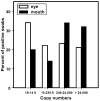HSV-1 DNA in tears and saliva of normal adults
- PMID: 15623779
- PMCID: PMC1200985
- DOI: 10.1167/iovs.04-0614
HSV-1 DNA in tears and saliva of normal adults
Abstract
Purpose: To assess the frequency of shedding of herpes simplex virus type 1 (HSV-1) DNA in tears and saliva of asymptomatic individuals.
Methods: Fifty subjects without signs of ocular herpetic disease participated. Serum samples from all subjects were tested for HSV IgG antibodies by enzyme-linked immunosorbent assay (ELISA) and for HSV-1 by neutralization assay. HSV-1 DNA copy number and frequency of shedding were determined by real-time polymerase chain reaction (PCR) analysis of tear and saliva samples collected twice daily for 30 consecutive days.
Results: Thirty-seven (74%) of the 50 subjects were positive for HSV IgG by ELISA. The percentages of positive eye and mouth swabs were approximately equivalent: 33.5% (941/2806) and 37.5% (1020/2723), respectively. However, the percentage of samples with high HSV-1 genome copy numbers was greater in saliva than in tears, which may have been a result of the sample volume collected. Shedding frequency in tears was nearly the same in men (347/1003; 34.6%) and women (594/1705; 34.8%); in saliva, men had a higher frequency of shedding (457/1009; 45.3% vs. 563/1703; 33.1%, men versus women). Overall, 49 (98%) of 50 subjects shed HSV-1 DNA at least once during the course of the 30-day study.
Conclusions: The percentage of asymptomatic subjects who intermittently shed HSV-1 DNA in tears or saliva was higher than the percentage of subjects with positive ELISA or neutralization antibodies to HSV. Because most HSV transmission occurs during asymptomatic shedding, further knowledge of the prevalence of HSV-1 DNA in tears and saliva is warranted to control its spread. Shedding is simple to study, and its suppression may be an efficient way to evaluate new antivirals in humans.
Figures




References
-
- Ling PD, Lednicky JA, Keitel WA, et al. The dynamics of herpesvirus and polyomavirus reactivation and shedding in healthy adults: a 14-month longitudinal study. J Infect Dis. 2003;187:1571–1580. - PubMed
-
- Ghebrekidan H, Ruden U, Cox S, Wahren B, Grandien M. Prevalence of herpes simplex virus types 1 and 2, cytomegalovirus, and varicella-zoster virus infections in Eritrea. J Clin Virol. 1999;12:53–64. - PubMed
-
- Coyle PK, Sibony PA. Viral antibodies in normal tears. Invest Ophthalmol Vis Sci. 1988;29:1552–1558. - PubMed
-
- Xu F, Schillinger J, Sternberg M, et al. Seroprevalence and coinfection with herpes simplex virus type 1 and type 2 in the United States, 1988–1994. J Infect Dis. 2002;185:1019–1024. - PubMed
-
- Carr DJJ, Härle P, Gebhardt BM. The immune response to ocular herpes simplex virus type 1 infection. Exp Biol Med. 2001;226:353–366. - PubMed
Publication types
MeSH terms
Substances
Grants and funding
LinkOut - more resources
Full Text Sources
Other Literature Sources
Medical

